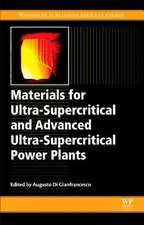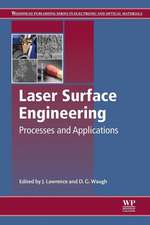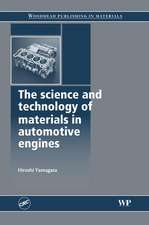Advances in Clean Hydrocarbon Fuel Processing: Science and Technology: Woodhead Publishing Series in Energy
Editat de M. Rashid Khanen Limba Engleză Paperback – 18 aug 2016
Advances in clean hydrocarbon fuel processing provides a comprehensive and systematic reference on the range of alternative conversion processes and technologies.
Following introductory overviews of the feedstocks, environmental issues and life cycle assessment for alternative hydrocarbon fuel processing, sections go on to review solid, liquid and gaseous fuel conversion. Solid fuel coverage includes reviews of liquefaction, gasification, pyrolysis and biomass catalysis. Liquid fuel coverage includes reviews of sulfur removal, partial oxidation and hydroconversion. Gaseous fuel coverage includes reviews of Fischer-Tropsch synthesis, methanol and dimethyl ether production, water-gas shift technology and natural gas hydrate conversion. The final section examines environmental degradation issues in fuel processing plants as well as automation, advanced process control and process modelling techniques for plant optimisation
Written by an international team of expert contributors, Advances in clean hydrocarbon fuel processing provides a valuable reference for fuel processing engineers, industrial petrochemists and energy professionals, as well as for researchers and academics in this field.
- A comprehensive reference on the range of alternative conversion processes and technologies
- Provides an overview of the feedstocks, environmental issues and life cycle assessments for alternative hydrocarbon fuel processing, including a review of the key issues in solid, liquid and gaseous fuel conversion
- Examines automation, advanced process control and process modelling techniques for plant optimisation
Din seria Woodhead Publishing Series in Energy
-
 Preț: 853.23 lei
Preț: 853.23 lei - 24%
 Preț: 1209.19 lei
Preț: 1209.19 lei - 24%
 Preț: 1307.96 lei
Preț: 1307.96 lei - 24%
 Preț: 1386.95 lei
Preț: 1386.95 lei - 9%
 Preț: 900.25 lei
Preț: 900.25 lei - 9%
 Preț: 1067.83 lei
Preț: 1067.83 lei - 29%
 Preț: 1071.46 lei
Preț: 1071.46 lei - 9%
 Preț: 950.40 lei
Preț: 950.40 lei - 9%
 Preț: 1011.50 lei
Preț: 1011.50 lei - 29%
 Preț: 1071.13 lei
Preț: 1071.13 lei - 9%
 Preț: 1309.35 lei
Preț: 1309.35 lei - 9%
 Preț: 949.23 lei
Preț: 949.23 lei - 24%
 Preț: 1688.64 lei
Preț: 1688.64 lei - 9%
 Preț: 1344.70 lei
Preț: 1344.70 lei - 9%
 Preț: 1049.56 lei
Preț: 1049.56 lei - 27%
 Preț: 1937.44 lei
Preț: 1937.44 lei - 23%
 Preț: 1519.01 lei
Preț: 1519.01 lei - 23%
 Preț: 1074.68 lei
Preț: 1074.68 lei - 29%
 Preț: 981.24 lei
Preț: 981.24 lei - 9%
 Preț: 1397.24 lei
Preț: 1397.24 lei - 39%
 Preț: 1397.48 lei
Preț: 1397.48 lei - 9%
 Preț: 945.89 lei
Preț: 945.89 lei - 9%
 Preț: 1073.87 lei
Preț: 1073.87 lei - 9%
 Preț: 1514.09 lei
Preț: 1514.09 lei - 9%
 Preț: 1020.23 lei
Preț: 1020.23 lei - 39%
 Preț: 880.81 lei
Preț: 880.81 lei - 9%
 Preț: 950.94 lei
Preț: 950.94 lei - 39%
 Preț: 1225.96 lei
Preț: 1225.96 lei - 9%
 Preț: 1214.08 lei
Preț: 1214.08 lei - 39%
 Preț: 1085.98 lei
Preț: 1085.98 lei - 9%
 Preț: 868.43 lei
Preț: 868.43 lei - 24%
 Preț: 1615.93 lei
Preț: 1615.93 lei - 31%
 Preț: 927.68 lei
Preț: 927.68 lei - 24%
 Preț: 1077.86 lei
Preț: 1077.86 lei - 9%
 Preț: 946.04 lei
Preț: 946.04 lei - 9%
 Preț: 952.05 lei
Preț: 952.05 lei - 9%
 Preț: 1165.33 lei
Preț: 1165.33 lei - 24%
 Preț: 1307.96 lei
Preț: 1307.96 lei - 29%
 Preț: 1213.47 lei
Preț: 1213.47 lei - 24%
 Preț: 1075.25 lei
Preț: 1075.25 lei - 24%
 Preț: 1048.44 lei
Preț: 1048.44 lei - 29%
 Preț: 1454.22 lei
Preț: 1454.22 lei - 39%
 Preț: 1285.27 lei
Preț: 1285.27 lei - 9%
 Preț: 952.68 lei
Preț: 952.68 lei - 23%
 Preț: 878.04 lei
Preț: 878.04 lei - 9%
 Preț: 951.98 lei
Preț: 951.98 lei - 9%
 Preț: 1209.42 lei
Preț: 1209.42 lei - 9%
 Preț: 1233.82 lei
Preț: 1233.82 lei
Preț: 1047.65 lei
Preț vechi: 1709.16 lei
-39% Nou
Puncte Express: 1571
Preț estimativ în valută:
200.49€ • 208.54$ • 165.52£
200.49€ • 208.54$ • 165.52£
Carte tipărită la comandă
Livrare economică 07-21 aprilie
Preluare comenzi: 021 569.72.76
Specificații
ISBN-13: 9780081016763
ISBN-10: 008101676X
Pagini: 584
Dimensiuni: 156 x 234 x 30 mm
Greutate: 0.8 kg
Editura: ELSEVIER SCIENCE
Seria Woodhead Publishing Series in Energy
ISBN-10: 008101676X
Pagini: 584
Dimensiuni: 156 x 234 x 30 mm
Greutate: 0.8 kg
Editura: ELSEVIER SCIENCE
Seria Woodhead Publishing Series in Energy
Cuprins
Contributor contact details
Woodhead Publishing Series in Energy
Part I: Overview and assessment of hydrocarbon fuel conversion processes
Chapter 1: Characterization and preparation of biomass, oil shale and coal-based feedstocks
Abstract:
1.1 Introduction
1.2 Types and properties of feedstock
1.3 Coal feedstock characterization and requirements
1.4 Coal cleaning and preparation techniques
1.5 Coal slurry fuels
1.6 Future trends
1.7 Sources of further information and advice
Chapter 2: Production, properties and environmental impact of hydrocarbon fuel conversion
Abstract:
2.1 Introduction
2.2 Production of hydrocarbon fuels
2.3 Properties of hydrocarbon fuels
2.4 Use and energy efficiency
2.5 Environmental impact
2.6 Toxicity hazards
2.7 Future trends in fuels production and properties
Chapter 3: Life cycle assessment (LCA) of alternative hydrocarbon fuel conversion
Abstract:
3.1 Introduction
3.2 Life cycle assessment: environmental, energetic and techno-economic issues
3.3 Life cycle assessment of fuel conversion routes and alternative feedstock utilisation
3.4 Conclusions and future trends
3.5 Sources of further information and advice
Part II: Solid hydrocarbon fuel processing and technology
Chapter 4: Direct liquefaction (DCL) processes and technology for coal and biomass conversion
Abstract:
4.1 Introduction
4.2 Feedstocks for direct liquefaction
4.3 Basics of coal and biomass/lignin reaction chemistry
4.4 Process variables: coal rank, solvent, catalyst, temperature, pressure and residence time in direct liquefaction (DCL)
4.5 Known process technologies
4.6 Product output and quality issues
4.7 Process control and modeling techniques
4.8 Advantages and limitations
4.9 Future trends in direct coal liquefaction
4.10 Sources of further information and advice
Chapter 5: Gasification process technology
Abstract:
5.1 Introduction
5.2 Gasification in the refinery environment
5.3 Basic principles
5.4 Building blocks for complete systems
5.5 Hydrogen and power plant as an example for a complete system
5.6 Advantages and limitations
5.7 Future trends
5.8 Sources of further information and advice
Chapter 6: Pyrolysis processes and technology for the conversion of hydrocarbons and biomass
Abstract:
6.1 Introduction
6.2 Applicable feedstocks
6.3 Process technology
6.4 Basic reactions
6.5 Thermodynamics/reaction kinetics
6.6 Catalyst and solvent utilization
6.7 Conclusion and future trends
Chapter 7: Biomass catalysis in conventional refineries
Abstract:
7.1 Introduction
7.2 Biomass feedstock: availability and diversity
7.3 Catalytic cracking of biomass feedstock
7.4 Hydrotreating of biomass feedstock
7.5 Production of conventional liquid fuels from sugars
7.6 Future trends
Part III: Liquid hydrocarbon fuel processing and technology
Chapter 8: Sulfur removal from heavy and light petroleum hydrocarbon by selective oxidation
Abstract:
8.1 Introduction
8.2 Background
8.3 Oxidative desulfurization chemistry
8.4 Conclusions
Chapter 9: Partial oxidation (POX) processes and technology for clean fuel and chemical production
Abstract:
9.1 Introduction
9.2 Process technology and methods of partial oxidation (POX)
9.3 Basic partial oxidation reactions
9.4 Catalysts utilized
9.5 Process control and modelling techniques
9.6 Advantages, limitations and optimization
9.7 Future trends
Chapter 10: Hydroconversion processes and technology for clean fuel and chemical production
Abstract:
10.1 Introduction to petroleum refining
10.2 Environmental protection
10.3 Hydroconversion overview
10.4 Economics of hydroconversion
10.5 Chemistry of hydroconversion
10.6 Supported-metal hydroconversion catalyst
10.7 Commercial hydroconversion units
10.8 Future trends in hydroconversion
Part IV: Gaseous hydrocarbon fuel processing and technology
Chapter 11: Middle distillate fuel production from synthesis gas via the Fischer–Tropsch process
Abstract:
11.1 Introduction
11.2 Process technology
11.3 Basic principles of the reaction process
11.4 Catalyst utilisation
11.5 Product upgrading and quality issues
11.6 Process modelling and control
11.7 Advantages, limitations and optimisation for synthetic middle distillate fuels
11.8 Future trends
11.9 Sources of further information and advice
Chapter 12: Methanol and dimethyl ether (DME) production from synthesis gas
Abstract:
12.1 Introduction
12.2 Process technology and new innovations
12.3 Basic principles of methanol synthesis
12.4 Catalysts
12.5 Product quality
12.6 Estimation of production costs
12.7 Future trends
12.8 Sources of further information and advice
Chapter 13: Advances in water-gas shift technology: modern catalysts and improved reactor concepts
Abstract:
13.1 Introduction
13.2 Modern reactor concepts
13.3 Advanced catalytic systems
13.4 Conclusions and future trends
Chapter 14: Natural gas hydrate conversion processes
Abstract:
14.1 Introduction
14.2 Factors important for hydrate conversion
14.3 Resource potential
14.4 Conversion processes
14.5 Advantages, limitations and optimization
14.6 Future trends
14.7 Sources of further information and advice
Part V: Operational issues and process improvement in hydrocarbon fuel processing plant
Chapter 15: Environmental degradation in hydrocarbon fuel processing plant: issues and mitigation
Abstract:
15.1 Introduction
15.2 Types of degradation and their main locations
15.3 Protection and mitigation technologies
15.4 Plant management techniques
15.5 Future trends
15.6 Sources of further information and advice
Chapter 16: Automation technology in hydrocarbon fuel processing plant
Abstract:
16.1 Introduction
16.2 Automation technology survey: from exploration to processing
16.3 Fundamentals of process control
16.4 Control design
16.5 Future trends in automation technology
16.6 Working towards a broader integration of control and operation
16.7 Conclusions
Chapter 17: Advanced process control for clean fuel production: smart plant of the future
Abstract:
17.1 Introduction
17.2 Incentives for smart process control technologies
17.3 Smart instrumentation of the future
17.4 Advanced process control (APC) and optimization solutions
17.5 Model predictive control technology (MPC)
17.6 Real-time optimization (RTO) technology
17.7 Control performance monitoring (CPM)
17.8 Driving future innovation, sustainability and performance in process control technologies
Chapter 18: Process modeling for hydrocarbon fuel conversion
Abstract:
18.1 Computational fluid dynamics (CFD) modeling techniques
18.4 Chemical kinetic modeling
Index
Woodhead Publishing Series in Energy
Part I: Overview and assessment of hydrocarbon fuel conversion processes
Chapter 1: Characterization and preparation of biomass, oil shale and coal-based feedstocks
Abstract:
1.1 Introduction
1.2 Types and properties of feedstock
1.3 Coal feedstock characterization and requirements
1.4 Coal cleaning and preparation techniques
1.5 Coal slurry fuels
1.6 Future trends
1.7 Sources of further information and advice
Chapter 2: Production, properties and environmental impact of hydrocarbon fuel conversion
Abstract:
2.1 Introduction
2.2 Production of hydrocarbon fuels
2.3 Properties of hydrocarbon fuels
2.4 Use and energy efficiency
2.5 Environmental impact
2.6 Toxicity hazards
2.7 Future trends in fuels production and properties
Chapter 3: Life cycle assessment (LCA) of alternative hydrocarbon fuel conversion
Abstract:
3.1 Introduction
3.2 Life cycle assessment: environmental, energetic and techno-economic issues
3.3 Life cycle assessment of fuel conversion routes and alternative feedstock utilisation
3.4 Conclusions and future trends
3.5 Sources of further information and advice
Part II: Solid hydrocarbon fuel processing and technology
Chapter 4: Direct liquefaction (DCL) processes and technology for coal and biomass conversion
Abstract:
4.1 Introduction
4.2 Feedstocks for direct liquefaction
4.3 Basics of coal and biomass/lignin reaction chemistry
4.4 Process variables: coal rank, solvent, catalyst, temperature, pressure and residence time in direct liquefaction (DCL)
4.5 Known process technologies
4.6 Product output and quality issues
4.7 Process control and modeling techniques
4.8 Advantages and limitations
4.9 Future trends in direct coal liquefaction
4.10 Sources of further information and advice
Chapter 5: Gasification process technology
Abstract:
5.1 Introduction
5.2 Gasification in the refinery environment
5.3 Basic principles
5.4 Building blocks for complete systems
5.5 Hydrogen and power plant as an example for a complete system
5.6 Advantages and limitations
5.7 Future trends
5.8 Sources of further information and advice
Chapter 6: Pyrolysis processes and technology for the conversion of hydrocarbons and biomass
Abstract:
6.1 Introduction
6.2 Applicable feedstocks
6.3 Process technology
6.4 Basic reactions
6.5 Thermodynamics/reaction kinetics
6.6 Catalyst and solvent utilization
6.7 Conclusion and future trends
Chapter 7: Biomass catalysis in conventional refineries
Abstract:
7.1 Introduction
7.2 Biomass feedstock: availability and diversity
7.3 Catalytic cracking of biomass feedstock
7.4 Hydrotreating of biomass feedstock
7.5 Production of conventional liquid fuels from sugars
7.6 Future trends
Part III: Liquid hydrocarbon fuel processing and technology
Chapter 8: Sulfur removal from heavy and light petroleum hydrocarbon by selective oxidation
Abstract:
8.1 Introduction
8.2 Background
8.3 Oxidative desulfurization chemistry
8.4 Conclusions
Chapter 9: Partial oxidation (POX) processes and technology for clean fuel and chemical production
Abstract:
9.1 Introduction
9.2 Process technology and methods of partial oxidation (POX)
9.3 Basic partial oxidation reactions
9.4 Catalysts utilized
9.5 Process control and modelling techniques
9.6 Advantages, limitations and optimization
9.7 Future trends
Chapter 10: Hydroconversion processes and technology for clean fuel and chemical production
Abstract:
10.1 Introduction to petroleum refining
10.2 Environmental protection
10.3 Hydroconversion overview
10.4 Economics of hydroconversion
10.5 Chemistry of hydroconversion
10.6 Supported-metal hydroconversion catalyst
10.7 Commercial hydroconversion units
10.8 Future trends in hydroconversion
Part IV: Gaseous hydrocarbon fuel processing and technology
Chapter 11: Middle distillate fuel production from synthesis gas via the Fischer–Tropsch process
Abstract:
11.1 Introduction
11.2 Process technology
11.3 Basic principles of the reaction process
11.4 Catalyst utilisation
11.5 Product upgrading and quality issues
11.6 Process modelling and control
11.7 Advantages, limitations and optimisation for synthetic middle distillate fuels
11.8 Future trends
11.9 Sources of further information and advice
Chapter 12: Methanol and dimethyl ether (DME) production from synthesis gas
Abstract:
12.1 Introduction
12.2 Process technology and new innovations
12.3 Basic principles of methanol synthesis
12.4 Catalysts
12.5 Product quality
12.6 Estimation of production costs
12.7 Future trends
12.8 Sources of further information and advice
Chapter 13: Advances in water-gas shift technology: modern catalysts and improved reactor concepts
Abstract:
13.1 Introduction
13.2 Modern reactor concepts
13.3 Advanced catalytic systems
13.4 Conclusions and future trends
Chapter 14: Natural gas hydrate conversion processes
Abstract:
14.1 Introduction
14.2 Factors important for hydrate conversion
14.3 Resource potential
14.4 Conversion processes
14.5 Advantages, limitations and optimization
14.6 Future trends
14.7 Sources of further information and advice
Part V: Operational issues and process improvement in hydrocarbon fuel processing plant
Chapter 15: Environmental degradation in hydrocarbon fuel processing plant: issues and mitigation
Abstract:
15.1 Introduction
15.2 Types of degradation and their main locations
15.3 Protection and mitigation technologies
15.4 Plant management techniques
15.5 Future trends
15.6 Sources of further information and advice
Chapter 16: Automation technology in hydrocarbon fuel processing plant
Abstract:
16.1 Introduction
16.2 Automation technology survey: from exploration to processing
16.3 Fundamentals of process control
16.4 Control design
16.5 Future trends in automation technology
16.6 Working towards a broader integration of control and operation
16.7 Conclusions
Chapter 17: Advanced process control for clean fuel production: smart plant of the future
Abstract:
17.1 Introduction
17.2 Incentives for smart process control technologies
17.3 Smart instrumentation of the future
17.4 Advanced process control (APC) and optimization solutions
17.5 Model predictive control technology (MPC)
17.6 Real-time optimization (RTO) technology
17.7 Control performance monitoring (CPM)
17.8 Driving future innovation, sustainability and performance in process control technologies
Chapter 18: Process modeling for hydrocarbon fuel conversion
Abstract:
18.1 Computational fluid dynamics (CFD) modeling techniques
18.4 Chemical kinetic modeling
Index








